Do you have trouble finding flux core aluminum welding wire?
You’re not alone. There’s plenty of confusion on this topic and even some deception.
Also referred to as gasless aluminum welding wire, it sounds like a suitable option for a minor welding job. And one that can save you hundreds on MIG welding gas and a spool gun.
Plus, if your welder is a flux core-only model, it’s your only option. Or is it?
Let’s discover what’s real and what’s the myth: Does aluminum flux core welding wire even exist? And, can you weld aluminum with a flux core welder?

My Search For Flux Core Aluminum Wire – What’s Real?
A simple internet search turns up interesting, but mostly unhelpful results that contribute to the confusion.
Flux Core Soldering and Brazing Wire
While these are flux-cored filler materials for joining aluminum, soldering and brazing are different processes that don’t work in a welder. Arc welding is just too hot for this wire.

Although not what we’re looking for, brazing rods are a handy way to join aluminum material without expensive gear. If you learn this technique and keep a few rods on hand, someday you’ll be glad you did.
Product Ads
For searches of “gasless aluminum mig wire” or other similar queries, Google serves up ads that look promising.
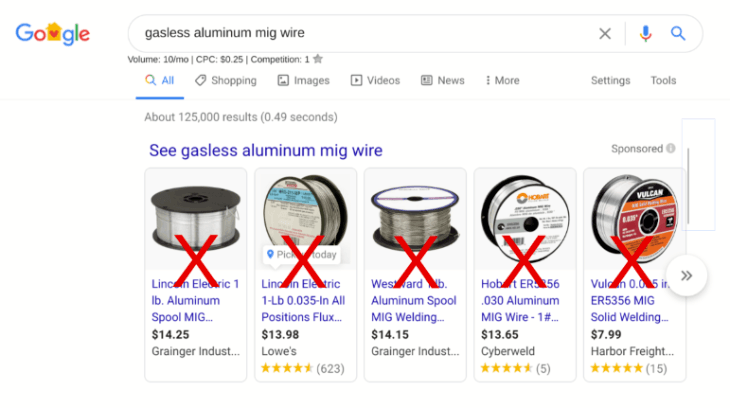
But no success. The products are solid aluminum or flux core steel wire. They won’t work on aluminum, or needs a shielding gas.
“Do-it-all” Welding Machines
This 4-in-1 welder caught my attention. Maybe the manufacturer also sells consumables?
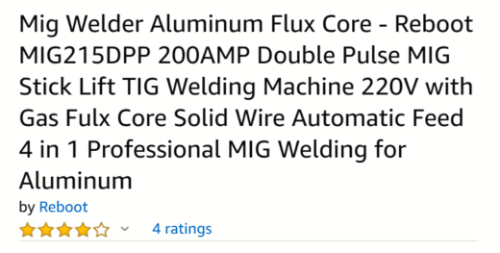
No, another strike. Capable of both aluminum and flux core welding, this machine is definitely not an aluminum flux core machine.
Fake Flux Core Aluminum Welding Wire
The title of this one on eBay looks like a winner…
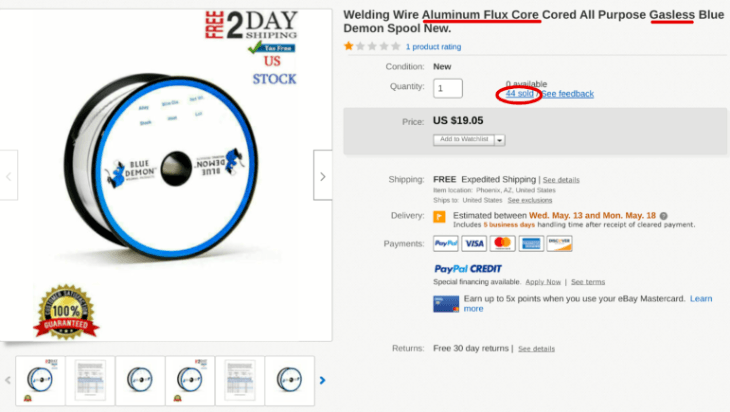
It mentions:
✔ Aluminum
✔ Flux Core
✔ Cored (for reassurance)
✔ Gasless
✔ No mention of solid wire
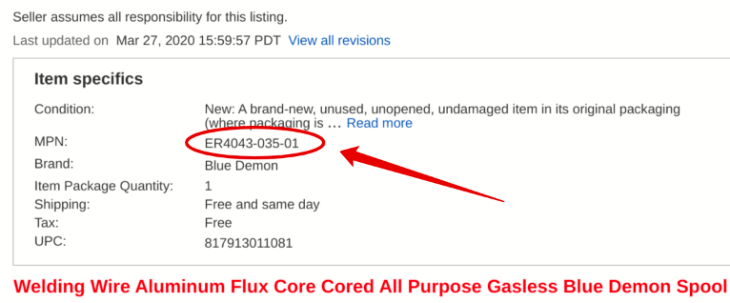
But, wait—further down it lists Blue Demon’s part number for a one-pound spool of 0.035 diameter solid aluminum wire. This wire needs Argon gas.
As this buyer found out:

Too bad, but thanks to him for giving others a heads-up.
What I Didn’t Find
I agreed with the above review. Proof that aluminum wire designed for flux core arc welding (FCAW) machines is real had eluded me.
Confirmation came when I saw this chart of filler metal specifications from the American Welding Society (AWS):
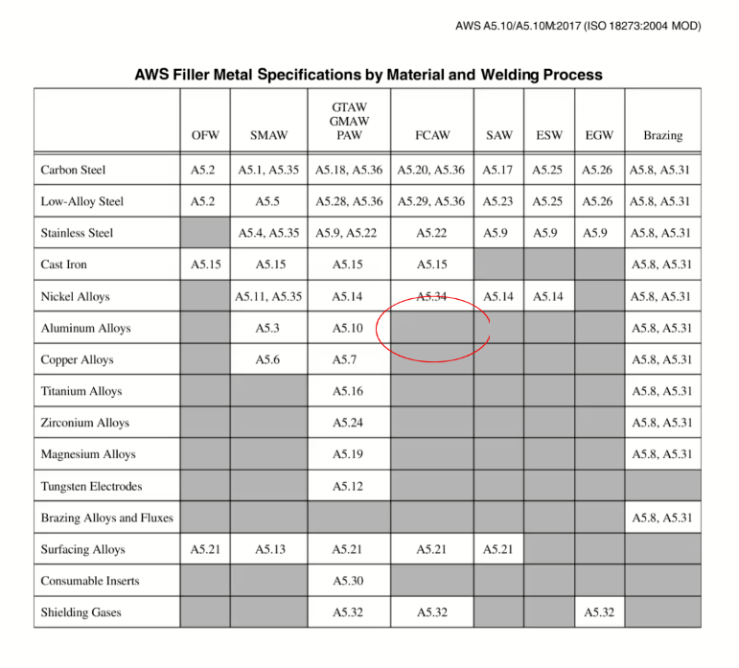
When AWS doesn’t list FCAW aluminum welding wire specs, it’s time to admit defeat. This wire does not exist.
Why No Flux Core Aluminum Welding Wire?
Several problems prevent the use of FCAW aluminum wire. These include usability and quality issues.
Hard to Feed
Even solid aluminum wire is soft and tricky to feed. Just imagine trying to feed a hollowed-out flux core wire without crushing and jamming. Basic wire drives just wouldn’t be up to the task. It would take a specialized drive system.
Poor Flux Properties
Because of aluminum’s unique characteristics, fluxes designed for carbon or stainless steel do not work. And fluxes used in soldering and brazing aren’t effective at arc welding’s higher temperatures.
Also, aluminum fluxes tested for welding are extremely corrosive. This is a concern for both users and the environment. Plus, the fluxes are hygroscopic and absorb water from the air. These traits contribute to poor weld quality and excessive spatter.
Nature of FCAW
Flux core arc welding on steel can generate a lot of spatter. The fluid nature of aluminum at welding temps would magnify the problem. The amount of molten material expelled from the weld would reduce weld quality and appearance.
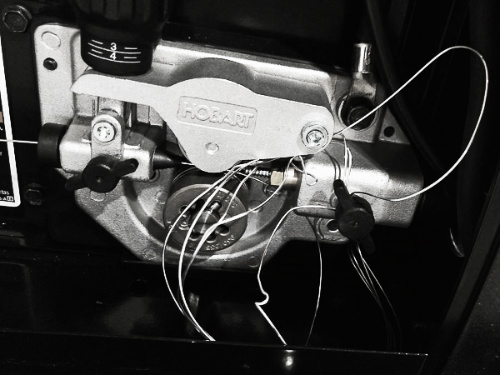
Alternatives To Flux Core Welding to Join Aluminum?
We now know that we can’t weld aluminum with flux core using a wire-feed welder. So let’s look at other options you can use to make a repair or build your project.
MIG Welding
You could install a spool gun on a compatible welder. That, along with a cylinder of 100% Argon welding gas, and a small spool of solid aluminum wire is an efficient and reliable method.
If your welder isn’t spool gun ready, or you just want to save some money, try MIG welding aluminum without a spool gun. For the price of a roll of wire, and maybe a liner, you’ll find out if your machine is capable. A bit of patience and practice can yield surprising results.
TIG Welding
An AC TIG welder with pure Argon shielding gas can provide the nicest-looking welds. As with all aluminum welding, it’ll take some practice. Remember, it’s a manual process that’s slower than MIG. TIG is best for minor projects.
In a pinch, a DC TIG welder, along with flux-coated stick welding rods, can get the job done.
Stick Welding
A stick welder with flux-coated welding rods is an alternative.
Soldering/Brazing
If you’re into metalworking, consider adding soldering and brazing to your tool kit.
Both processes heat the workpiece to the melting point of the filler material—not the base metal. Lower heat than arc welding means less risk of deforming the base metals.
“Brazing and soldering are processes that have many great advantages…good joint design will result in joint strength equal to or higher than that of welding.”
L. Jeffus “Welding Principles and Applications” (8th Edition, p. 816)
840℉ is the dividing line for the processes—with soldering occurring below and brazing above this temperature.
Capillary action draws the filler to fill voids between pieces. You can even join dissimilar metals.
You can get started with a simple torch, a small bottle of MAPP gas, and some aluminum rods.
Here are some brazing how-to tips from Bernzomatic
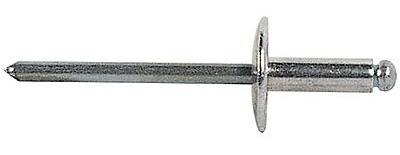
Rivets
This is so easy, yet gives a nice finished look to a project.
Get a good rivet gun and some stainless steel or aluminum rivets. Drill holes. Insert rivets. Works well enough for boats and planes.
For extensive projects, a pneumatic gun can help, or here’s a battery-operated model.
The Big Picture
Aluminum has unique qualities that make it an attractive project material.
Other characteristics prevent the development of a flux core aluminum welding wire having reliable weld quality that is safe and easy to use.

